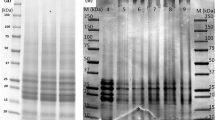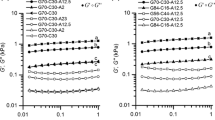Abstract
Organic aerogels based on two important and widely abundant renewable resources, soy proteins (SP) and nanofibrillar cellulose (NFC) are developed from precursor aqueous dispersions and a facile method conducive of channel- and defect-free systems after cooling and freeze-drying cycles that yielded apparent densities on the order of 0.1 g/cm3. NFC loading drives the internal morphology of the composite aerogels to transition from network- to fibrillar-like, with high density of interconnected cells. Composite aerogels with SP loadings as high as ca. 70 % display a compression modulus of 4.4 MPa very close to that obtained from reference, pure NFC aerogels. Thus, the high compression modulus of the composite system is not compromised as long as a relatively low amount of reinforcing NFC is present. The composite materials gain moisture (up to 5 %) in equilibrium with 50 % RH air, independent of SP content. Furthermore, their physical integrity is unchanged upon immersion in polar and non-polar solvents. Fast liquid sorption rates are observed in the case of composite aerogels in contact with hexane. In contrast, water sorption is modulated by the chemical composition of the aerogel, with an important contribution from swelling. The potential functionalities of the newly developed SP–NFC composite green materials can benefit from the reduced material cost and the chemical features brought about the amino acids present in SPs.






Similar content being viewed by others
References
Blomfeldt TOJ, Olsson RT, Menon M, Plackett D, Johansson E, Hedenqvist MS (2010) Novel foams based on freeze-dried renewable vital wheat gluten. Macromol Mater Eng 295:796–801. doi:10.1002/mame.201000049
Endres JG (2001) Soy protein products: characteristics, nutritional aspects, and utilization. AOCS Press, Champaign, IL
Goli KK, Rojas OJ, Oezcam AE, Genzer J (2012) Generation of functional coatings on hydrophobic surfaces through deposition of denatured proteins followed by grafting from polymerization. Biomacromolecules 13:1371–1382. doi:10.1021/bm300075u
Granström M, Pääkkö MKN, Jin H, Kolehmainen E, Kilpeläinen I, Ikkala O (2011) Highly water repellent aerogels based on cellulose stearoyl esters. Polym Chem 2:1789–1796. doi:10.1039/c0py00309c,a
Gurav JL, Jung I, Park H, Kang ES, Nadargi DY (2010) Silica aerogel: synthesis and applications. J Nanomater 409310. doi:10.1155/2010/409310
Jin H, Kettunen M, Laiho A, Pynnonen H, Paltakari J, Marmur A, Ikkala O, Ras RHA (2011) Superhydrophobic and superoleophobic nanocellulose aerogel membranes as bioinspired cargo carriers on water and oil. Langmuir 27:1930–1934. doi:10.1021/la103877r
Kettunen M, Silvennoinen RJ, Houbenov N, Nykanen A, Ruokolainen J, Sainio J, Pore V, Kemell M, Ankerfors M, Lindstrom T, Ritala M, Ras RHA, Ikkala O (2011) Photoswitchable superabsorbency based on nanocellulose aerogels. Adv Funct Mater 21:510–517. doi:10.1002/adfm.201001431
Khalil HPSA, Bhat AH, Yusra AFI (2012) Green composites from sustainable cellulose nanofibrils: a review. Carbohydr Polym 87:963–979. doi:10.1016/j.carbpol.2011.08.078
Koga H, Azetsu A, Tokunaga E, Saito T, Isogai A, Kitaoka T (2012) Topological loading of Cu(I) catalysts onto crystalline cellulose nanofibrils for the Huisgen click reaction. J Mater Chem 22:5538–5542. doi:10.1039/c2jm15661j
Korhonen JT, Kettunen M, Ras RHA, Ikkala O (2011) Hydrophobic nanocellulose aerogels as floating, sustainable, reusable, and recyclable oil absorbents. ACS Appl Mater Interfaces 3:1813–1816. doi:10.1021/am200475b
Li WL, Lu K, Walz JY (2012) Freeze casting of porous materials: review of critical factors in microstructure evolution. Int Mater Rev 57:37–60. doi:10.1179/1743280411Y.0000000011
Luyten J, Mullens S, Thijs I (2010) Designing with pores—synthesis and applications. KONA Powder Part J 28:131–142
Menzel N, Ortel E, Kraehnert R, Strasser P (2012) Electrocatalysis using porous nanostructured materials. ChemPhysChem 13:1385–1394. doi:10.1002/cphc.201100984
Munch E, Launey ME, Alsem DH, Saiz E, Tomsia AP, Ritchie RO (2008) Tough, bio-inspired hybrid materials. Science 322:1516–1520. doi:10.1126/science.1164865
Nakagaito A, Iwamoto S, Yano H (2005) Bacterial cellulose: the ultimate nano-scalar cellulose morphology for the production of high-strength composites. Appl Phys A Mater Sci Process 80:93–97. doi:10.1007/s00339-004-2932-3
Olsson RT, Samir MASA, Salazar-Alvarez G, Belova L, Strom V, Berglund LA, Ikkala O, Nogues J, Gedde UW (2010) Making flexible magnetic aerogels and stiff magnetic nanopaper using cellulose nanofibrils as templates. Nat Nanotechnol 5:584–588. doi:10.1038/NNANO.2010.155
Paakko M, Vapaavuori J, Silvennoinen R, Kosonen H, Ankerfors M, Lindstrom T, Berglund LA, Ikkala O (2008) Long and entangled native cellulose I nanofibers allow flexible aerogels and hierarchically porous templates for functionalities. Soft Matter 4:2492–2499. doi:10.1039/b810371b
Reddy N, Yang Y (2011) Potential of plant proteins for medical applications. Trends Biotechnol 29:490–498. doi:10.1016/j.tibtech.2011.05.003
Renkema J, Lakemond C, de Jongh H, Gruppen H, van Vliet T (2000) The effect of pH on heat denaturation and gel forming properties of soy proteins. J Biotechnol 79:223–230. doi:10.1016/S0168-1656(00)00239-X
Salas C, Rojas OJ, Lucia LA, Hubbe MA, Genzer J (2012) Adsorption of glycinin and beta-conglycinin on silica and cellulose: surface interactions as a function of denaturation, pH, and electrolytes. Biomacromolecules 13:387–396. doi:10.1021/bm2014153
Sarmadi BH, Ismail A (2010) Antioxidative peptides from food proteins: a review. Peptides 31:1949–1956. doi:10.1016/j.peptides.2010.06.020
Sehaqui H, Zhou Q, Berglund LA (2011) High-porosity aerogels of high specific surface area prepared from nanofibrillated cellulose (NFC). Compos Sci Technol 71:1593–1599. doi:10.1016/j.compscitech.2011.07.003
Song F, Tang D, Wang X, Wang Y (2011) Biodegradable soy protein isolate-based materials: a review. Biomacromolecules 12:3369–3380. doi:10.1021/bm200904x
Wagner J, Gueguen J (1999) Surface functional properties of native, acid-treated, and reduced soy glycinin. 2. Emulsifying properties. J Agric Food Chem 47:2181–2187. doi:10.1021/jf9809784
Washburn E (1921) The dynamics of capillary flow. Phys Rev 17:273–283. doi:10.1103/PhysRev.17.273
Zhang Y, Riduan SN (2012) Functional porous organic polymers for heterogeneous catalysis. Chem Soc Rev 41:2083–2094. doi:10.1039/c1cs15227k
Zhong Z, Sun XS, Wang D (2007) Isoelectric pH of polyamide–epichlorohydrin modified soy protein improved water resistance and adhesion properties. J Appl Polym Sci 103:2261–2270. doi:10.1002/app.25388
Acknowledgments
LignoCell project, supported by the Finnish Funding Agency for Technology and Innovation (TEKES) and Academy of Finland is gratefully acknowledged. The authors are also thankful for funding support provided by the United Soybean Board (USB) under project numbers 2490 and 2466. We are grateful to Mika Kankkunen from Stora Enso for his help in performing tomography analyses. We appreciate very much the discussions with Prof. Olli Ikkala (Aalto University) and his group on the manufacture of cellulosic aerogels. Also, discussions with Dr. Joseph Jakes (Forest Products Lab, USDA) are gratefully acknowledged.
Author information
Authors and Affiliations
Corresponding author
Electronic supplementary material
Below is the link to the electronic supplementary material.
Rights and permissions
About this article
Cite this article
Arboleda, J.C., Hughes, M., Lucia, L.A. et al. Soy protein–nanocellulose composite aerogels. Cellulose 20, 2417–2426 (2013). https://doi.org/10.1007/s10570-013-9993-4
Received:
Accepted:
Published:
Issue Date:
DOI: https://doi.org/10.1007/s10570-013-9993-4




